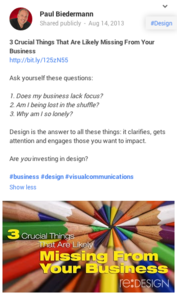 In this series about how social media and blogging work together, we’ve looked at the world’s most popular social networking sites: LinkedIn, Google+, Facebook, Twitter and YouTube.
In this series about how social media and blogging work together, we’ve looked at the world’s most popular social networking sites: LinkedIn, Google+, Facebook, Twitter and YouTube.
For today’s final post in the series, I’ve invited my friend Jeff Korhan to pull it all together for us. Author of Built-in Social, Jeff has a wonderful way of humanizing technical tools and marketing concepts and bringing the discussion back to the basics of good business.
Can you discuss the influences of social media on business activities today compared to how we operated before these digital media were available?
It is my belief that social media is influencing every aspect of the business environment, making it all more personal and transparent. What social media is really doing is democratizing media by giving everyone a voice. This is especially relevant for consumers that now collectively have a powerful voice that can stand up to that of any organization or corporation.
So, the challenge is avoiding the temptation to make social media another layer to add to your current marketing practices. More than just integrating it with your marketing program, its qualities should be built into all of your business growth practices to earn the trust of your community. Therefore, it’s important to thoroughly understand what got you here, and then use the qualities of social media to make them more relevant.
You will often hear it said that because business has significantly changed, what got you here will not take your business to the next level. That’s crazy! Your strengths never change. If you were fast, or strong, or witty, you still are. What’s important today is learning how to adapt or translate traditional business practices to a digital world that is also becoming profoundly social.
So, regardless of whether a business has been sales, marketing, customer service, or production driven, it should stick to what got it here and learn to adapt to the influences of these digital and social media.
This can be an amazingly prosperous time for businesses if they learn to understand the influences of social media on the buying behaviors of their customers, and then redesign their traditional practices to make them relevant for this connected economy.
Many people are so overwhelmed by social media that they don’t even know where to start. What do you recommend as the best way to begin using a social networking site for your business?
Start by observing. Notice what others are doing, and reconcile that with your business and its resources. Social media can get very personal, so it’s important to use it in a way that is congruent with who you really are. In fact, that transparency tends to work well for earning trust on each and every one of the social networks.
After that, take the time to build a strategy. Write it down; implement it; and refine it over time. The only way to make improvements is to create results that can be evaluated. I imagine that is how nearly all of us developed our proficiency – learning from successes and failures alike.
In the early days of social media we made a big deal out of the number of connections. What is clear now is that it’s more important to be better connected than the most connected.
Thus, a smart social media strategy should consider whom to connect with and how; and it should describe specific practices for encouraging engagement, and otherwise nurturing those network relationships over time.
Some people lump blogging into the same category as social media, but I tend to see it as something unique. What do you believe are the key connections that will help everyone use blogging and social media more effectively?
Personally, I like to think of my blog as my farm. It’s a place where I nurture and grow ideas that I then take to the social media marketplace for sharing and consumption.
Especially after Google’s Penguin and Panda updates, and now Google Authorship, it’s clear that we’ve progressed from blogging as a form of journaling, to now building viable digital marketing assets with solid content that will stand the test of time.
It’s important for businesses to now think of themselves as publishers, and even media companies. That mindset alone will change your blogging and social media for the better. Media used to be something that we hired. Now we are the media, and we know better than anyone else what our customers want from us.
Any final thoughts you would like to share?
Sure. Well, you and I have been doing this for the better part of seven years or so, and we have collaborated on a number of projects such as this. I’m convinced that blogging is absolutely essential not only for success with social media, but it’s also where the business world is going in general. Everyone should consider how lucky they are to have this amazing resource, and of course, be consistently learning how to use it to run a better business.
 Jeff Korhan, MBA, is the author of Built-In Social: Essential Social Marketing Practices for Every Small Business (Wiley 2013).
Jeff Korhan, MBA, is the author of Built-In Social: Essential Social Marketing Practices for Every Small Business (Wiley 2013).
Jeff was a Fortune 50 Sales and Marketing Executive who later founded a landscape services company that was twice named Small Business of the Year during its two decades of operation. Today he helps mainstream small businesses adapt their traditional business growth practices to a digital world.
Jeff is a regular content contributor to leading business publications, with his own New Media and Small Business Marketing site ranking among the Top 100 Small Business Blogs in the world.
Enjoying this series about social media and blogging? Check out the other posts here. You can also find my post about using Twitter for business at Social Media Today.
 In this post we’ll get back to my interview with expert video marketer Anthony Idle from
In this post we’ll get back to my interview with expert video marketer Anthony Idle from  As we near the end of
As we near the end of  For expert insights, I went to
For expert insights, I went to  Paul Biedermann is creative director/owner of
Paul Biedermann is creative director/owner of 